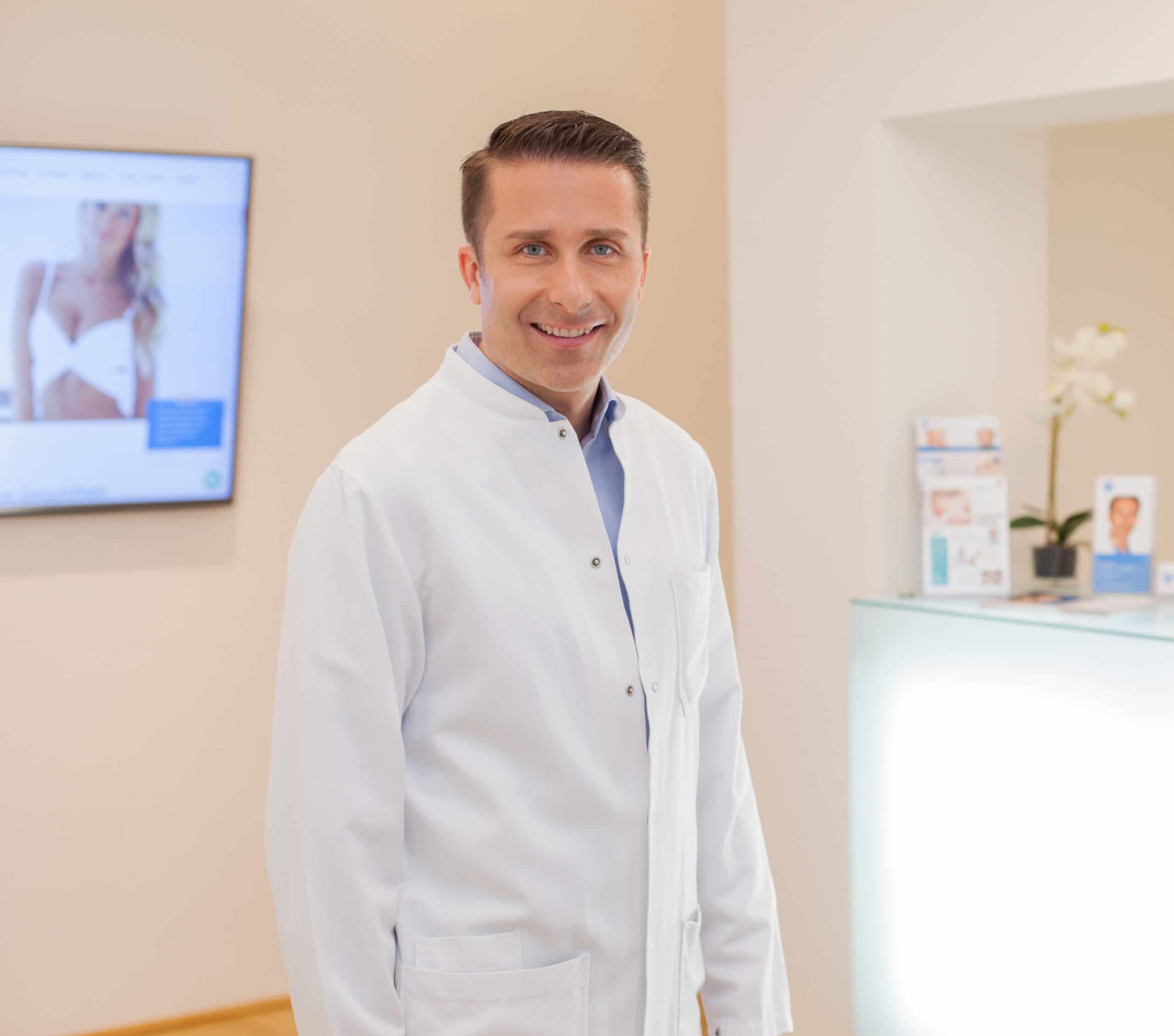The natural aging process of skin aging begins as early as the age of 25 and becomes more and more visible with advancing age. The aging of the skin is particularly noticeable on the face: the skin loses its elasticity and moisture, which causes more and more wrinkles to form and the skin appears slack and weak. But not only skin aging, facial expressions and environmental influences such as strong sunlight make themselves felt on our faces and lead to the fact that many people no longer find themselves beautiful and do not feel comfortable in their skin. Dissatisfaction with one’s own face can represent enormous psychological distress. Dr. Matiasek offers you reliable solutions in his practice to fulfill your desire for a younger, fresher and firmer face.
What is the difference between botox and hyaluronic acid?
Both botox and hyaluronic acid are used to give your skin a young, firm and wrinkle-free appearance. In the course of life, the level of firming hyaluronic acid in the skin decreases. As a result, the skin becomes less elastic over time, loses moisture and forms more and more wrinkles.
The term botox is based on the term botulinum toxin, which is synthetically produced from the bacterial strain of the bacterium Clostridium difficile. Botulinum toxin type A is used to treat wrinkles, in such small quantities that it cannot cause any harm to your body. The active ingredient inhibits the release of the messenger substance acetylcholine, which is normally responsible for tensing the facial muscles. As a result, your tissue can temporarily no longer contract and the skin is smoothed and tightened.
Hyaluronic acid, on the other hand, is an endogenous polysaccharide that occurs in our skin as well as in our bones and intervertebral discs, in our synovial fluid and in the vitreous humour of our eyes. Since sugar binds water, hyaluronic acid contributes to a fresh, young and plump appearance of the skin.
The main difference between them is how the two substances work. Botox relaxes the treated part of the facial muscles and thus makes wrinkles disappear. Hyaluronic acid, on the other hand, binds large amounts of water, which plumps up your skin from below and makes it appear smoother.
What can botox and hyaluronic acid treat?
With the help of botox or hyaluronic acid, Dr. Matiasek fulfills his patients’ desire for firm skin. By injecting botox or hyaluronic acid, he can smooth both superficial and deep facial wrinkles and thus give your face a fresh look again.
Botox is mainly used to treat facial wrinkles and dark circles. The optical enlargement of lips or the lifting of drooping eyebrows can also be carried out with Botox. In addition, movement disorders of muscles, excessive sweating and chronic migraines can be treated with Botox. By injecting hyaluronic acid, wrinkles can be treated and your skin quality can be improved. The active ingredient is particularly suitable for the lower third of the face, i.e. for correcting the nose, chin or cheeks. Hyaluronic acid is also used to correct and shape the buttocks, lips or breasts.

Botox and hyaluronic acid: what you need to consider before treatment
Before a botox or hyaluronic acid treatment, Dr. Matiasek will have a detailed consultation with you, asking you about any previous illnesses or interventions. He will also talk to you about possible risks and side effects of the treatment. In addition, Dr. Matiasek deals intensively with any intolerances on your part as well as with your wishes and expectations of the upcoming treatment. Above all, it is important that you deal with the factors that speak for or against a botox or hyaluronic acid treatment. In the course of this, any risks that may be associated with the treatment are also discussed. Then the corresponding part of the body is examined and an individual treatment plan is created.
Since the Botox treatment is very quick and uncomplicated, Dr. Matiasek can start with the first treatment at the initial consultation if the prerequisites are good. Therefore, you should show up for your appointment without make-up and before that you should refrain from alcohol and nicotine.
Before starting a hyaluronic acid treatment, however, you need to pay more attention to the following: two weeks before your injection, you should no longer take any antibiotics or cortisone. It is advisable to stop taking blood-thinning medication about a week in advance. The day before the procedure, you should completely avoid nicotine and alcohol and drink and eat enough to keep your circulation going. In addition, you should appear without make-up for the treatment.
How does the treatment with Botox and hyaluronic acid work?
The Botox and hyaluronic acid treatment are carried out on an outpatient basis, which is why you can leave the practice immediately afterwards. How exactly the treatment goes will depend on your cosmetic and/or health concerns.
In a routine Botox treatment, the skin areas to be treated are first disinfected. A very thin needle is then inserted into the skin tissue, with the Botulinum toxin type A being injected directly into your muscle. In addition to light bruises, small swellings can also occur, but these will quickly subside. This means that you are fit to be seen in public again immediately after the treatment and you do not have to calculate any downtime. The duration of treatment depends on the part of the body to be treated and the amount of botulinum toxin used. The entire treatment usually takes around 30 minutes.
Wrinkle injection with hyaluronic acid can also be carried out extremely quickly. Depending on the extent of the body area to be treated, the procedure can be completed in around 30 to 60 minutes. In doing so, Dr. Matiasek uses the hyaluronic acid filler in superficial or deep skin structures. The appropriate strength of the acid is selected depending on the texture of the skin, position and depth of the wrinkles. If desired, the area to be treated can also be numbed with a cream beforehand so that you do not feel the puncture. After the injection, the active ingredient is massaged into your skin with light pressure so that the acid is optimally distributed to the desired skin area.
What are the possible side effects after botox and hyaluronic acid treatment?
The injection of botulinum toxin is considered to be extremely low-risk. Only in some cases can there be slight redness, swelling or small bruises at the injection sites. However, these disappear again within a very short time. Serious complications only occur after malpractice, which is extremely rare. These include sensory disturbances, headaches or nausea.
Side effects are also very rare with treatments with hyaluronic acid. Only a few patients feel pain or swelling after treatment. In very rare cases, bruises, a burning sensation or redness may also occur in the treated skin area. Even extremely rare nodules should subside after 14 days.
In contrast to Botox, hyaluronic acid often retains the natural facial expressions of your face, as it is an endogenous substance. For this reason, however, your body breaks down the active ingredient again over time, which is why you have to repeat the treatment from time to time. In addition, hyaluron is very well tolerated and extremely rarely shows side effects and complications.
Botox and hyaluronic acid: what you need to consider after treatment
After the botox injection has been completed, it is advisable to cool the treated skin area with a cooling compress. This will help prevent swelling and bruising. Basically, however, the puncture sites are barely visible, which is why you do not have to factor in any downtime. Nevertheless, it is advisable to take a day off and avoid facial massages or eyebrow plucking. You should also be careful when applying makeup.
After the hyaluronic acid treatment, it is advisable to cool the treated area with a cool pad that is not too cold in order to avoid pain and swelling. In addition, you should drink plenty of water for the first two weeks after treatment to help retain moisture. You should avoid nicotine for the first two hours after treatment and stop drinking alcohol for the rest of the day. You can only resume exercise after 48 hours. In addition, you should avoid going to the sauna and solarium in the first week after the treatment. Facial massage and other facial treatments are also not recommended for the first 14 days.
When are the results of the botox or hyaluronic acid treatment visible?
There is no immediate effect after Botox treatment. You will only see first improvements after about two to four days. The end result usually appears after one to two weeks.
After a hyaluronic acid injection, however, you can see an effect immediately after the treatment. In most cases, however, the injected area is still slightly swollen, but this should subside within a few days. After three weeks at the latest, the hyaluronic acid has released its full effect.
How long do the results with Botox or hyaluronic acid last?
How long the active ingredient injection will last depends on how much botulinum toxin is injected and how often the process is repeated,. On average, you can expect an effect for four months, as the body gradually breaks down the active ingredient. The duration of the effect also depends on how high a dose of Botox was used. As soon as the effect has subsided, a new injection can be started.
The duration of effect of hyaluronic acid also depends on the amount and consistency that is injected into the selected skin area. In addition, the stronger the water-binding capacity of your skin, the longer the result will last.
Together with you, Dr. Matiasek will find a way to give you a firm, young and wrinkle-free appearance. Dr. Matiasek and his team are always available.






